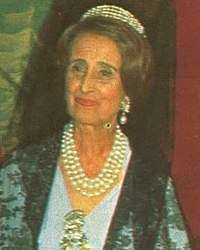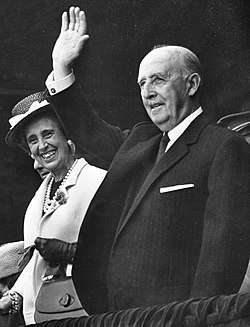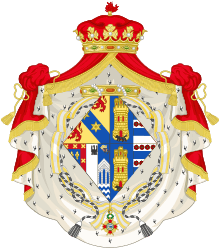Carmen Polo, 1st Lady of Meirás
María del Carmen Polo y Martínez-Valdés, 1st Lady of Meirás, Grandee of Spain (11 June 1900 – 6 February 1988) was the wife of General and caudillo Francisco Franco.
The Lady of Meirás Grandee | |
|---|---|
 Carmen Polo, 1972 | |
| Personal details | |
| Born | María del Carmen Polo y Martínez-Valdés 11 June 1900 Oviedo, Asturias, Spain |
| Died | 6 February 1988 (aged 87) Madrid, Spain |
| Nationality | Spanish |
| Spouse(s) | |
| Children | Carmen Franco, 1st Duchess of Franco |
| Parents | Felipe Polo y Flórez de Vereterra Ramona Martínez-Valdés y Martínez-Valdés |
She played an important role in Francoist Spain, exerting major influence in the election of Carlos Arias Navarro (when her husband was already ill) and in censoring the press.[1] She was, undoubtedly, the most influential woman in Francoist Spain. She was nicknamed as la Collares ('the one with the necklaces') in Spain.[2]
Family
She was the daughter of Felipe Polo y Flórez de Vereterra (1860–1926), a wealthy lawyer in Oviedo, and Ramona Martínez-Valdés y Martínez-Valdés (1870–8 February 1914), paternal granddaughter of Claudio Polo-Vereterra y Astudillo and wife Bonifacia Flórez and sister of María Isabel (married to José María Sanchíz y Sancho), Felipe and Ramona (Zita) (married in Oviedo on 6 February 1932 to Ramón Serrano Súñer). Her aunt Isabel Polo-Vereterra y Flórez married her relative Luis Vereterra y Estrada. Her great-grandparents were Telésforo Polo y Briz and Isabel Astudillo.[3]
Marriage
Her constant smile, pearl necklaces, the wedding's postponement became the inspiration for a verse of "La Madelón": "... el comandante Franco es un gran militar que aplazó su boda para ir a luchar..." ("...Commander Franco is a great soldier who postponed his wedding to go to war..."). It was two years before Franco returned to Oviedo.
When he returned, ready to marry, the death of Rafael de Valenzuela, successor to José Millán Astray as commander of the Spanish Legion, intervened. Franco was offered Valenzuela's command, and promotion to the rank of lieutenant colonel. His ambition was too great to resist the opportunity, and he left for Morocco on 18 July 1923, making this promise to his fiancée: "This year we will be married, above all else. If I do not die in combat, I will return to you." Having become Spain's most decorated soldier, Franco was eventually given a leave of forty days, and royal permission to marry. The wedding took place on 22 October 1923,[4] in the church of San Juan el Real of Oviedo. Franco's best man was King Alfonso XIII, represented by General Antonio Losada, military governor of Asturias. Serving as maid of honour was Isabel Polo, Carmen's aunt. The witnesses were the Marquis de la Vega de Anzo, and Franco's brothers, Nicolás and Ramón. Franco did not invite his father, Nicolás Franco, whom he had never forgiven for leaving his mother and living in Madrid with another woman.
Birth of only child
The honeymoon lasted only a few days. Franco was needed in North Africa, and he did not wish to be accompanied by his wife. This forced separation lasted fifteen months. At age 32, Franco was promoted to full colonel and made official commander of the Legion. He finally established a home, in Melilla, and Polo joined him. Franco soon rose to the rank of general. This began a new and difficult life for Polo, who would have to accustom herself to her husband's constant and unpredictable reassignments. They moved from Madrid to Zaragoza, back to Oviedo, to the Canary Islands, and after the Spanish Civil War, to Salamanca and Burgos. "I felt like an authentic nomad", she said on one occasion.
In the winter of 1926, Polo moved from Zaragoza to Oviedo, hoping to bear a son. The Francos had been married three years and had produced no children. This delay, abnormal at that time, gave rise to many rumours. In the end, Polo gave birth to a daughter, Carmen Franco y Polo,[5] known by the nicknames Nenuca, Carmencita, and Morita.
The Civil War and afterward
_-_Fondo_Car-Kutxa_Fototeka.jpg)
In July 1936, Polo and her daughter fled to Le Havre, France, on the German steamboat Waldi. They traveled under assumed names, fearing that Nenuca might be kidnapped. They waited in Le Havre for Antonio Barroso, who transported them to Bayonne, to the house of his former governess Claverie. At the end of September, Franco sent his cousin and confidant, Salgado-Araujo, to find them.
In September 1936 Franco was chosen and appointed "Generalísimo" and head of state by the National Defense Board (Junta de Defensa Nacional). Accordingly, Carmen Polo became known as the first lady of Spain. She was generally referred to simply as "La Señora". Her glamorous persona became part of Franco's image. It is rumored that Jose Antonio de Sangróniz, Franco's chief diplomat, was forced to cancel a reception before the Junta de Burgos ("Military Junta of Burgos", named after the town where it was formed) because Polo did not have suitable clothes for the occasion. She would never have this problem again. Beginning in 1936, she began to build up a large collection of hats, dresses, and pearl necklaces, the latter becoming her trademark.
First Lady

Polo almost always appeared with her husband. This caused some problems when traveling outside Madrid, since it required that Franco's ministers and advisers also be accompanied by their wives, creating problems with lodging. After the war's end, the question of the head of state's residence presented a problem. Franco was initially inclined to live in the Royal Palace, but was disabused of this notion by Ramón Serrano Súñer. Franco instead chose the Palacio Real de El Pardo, where he settled in March 1940 following its restoration. The Francos passed their summers at a home in Meirás, and fishing on their yacht Azor. The home, which had formerly belonged to Emilia Pardo Bazán, was, according to the official story, bought by "popular subscription" for more than 400,000 pesetas.
Polo embarked on many foreign trips during her time as first lady. She first traveled to Portugal in 1950, and returned in 1958 and 1967. She traveled to Rome in May 1950, to witness the canonization of Antonio María Claret. During the visit, she was granted an audience with Pope Pius XII. On none of her trips abroad was she ever accompanied by her husband.
El Pardo was the center of Spanish political life under Franco, and also the venue for many of the Franco family's personal events. Protocol was rigorously enforced, and largely dictated by la Señora, through the authority of the Casa Civil.
One of the most famous events of the Franco family was the marriage of the younger Carmen to Cristóbal Martínez-Bordiú, a son of the counts of Arguillo. In addition to his family's land holdings, he also carried the title of Marquis of Villaverde. This greatly pleased Polo, who had long held aspirations of nobility. The union produced several children, amongst others María del Carmen Martínez-Bordiú y Franco, the Francos' first grandchild.
Because of her fondness for wearing big pearl necklaces she was often referred to as La Collares, roughly Lady Necklaces.
Later years

Polo devoted her later years to her grandchildren. On 8 March 1972, her granddaughter María del Carmen married Alfonso, Duke of Anjou and Cádiz, a member of the House of Bourbon. Polo hoped that this "operation" would lead to her granddaughter becoming queen. In fact, Juan Carlos ultimately succeeded to the throne. By that time, Franco was greatly diminished, both physically and mentally. With Franco's death, the family's fortunes changed dramatically.
On 26 November 1975, six days after her husband's death, King Juan Carlos gave Polo the hereditary title Señora de Meirás (English: Lady of Meirás), named after her and her husband's summer residence. She was also given the accompanying dignity Grande de España (English: Grandee of Spain). The title and dignity were inherited by her grandson Francisco Franco (who also became the 11th Marquis of Villaverde after the death of his father).
In the ensuing years, Polo witnessed the disintegration of her family. On 31 January 1976, she left El Pardo for the last time. In 1978, her daughter Carmencita was arrested at Madrid Barajas International Airport for attempting to smuggle 300 million pesetas worth of gold, jewellery, and medals which had belonged to her father.[6] María del Carmen separated from her husband and moved to Paris, where she lived with the antiquarian Jean-Marie Rossi. On 7 February 1984, Polo's great-grandson Francisco ("Fran") was killed at age eleven in a car accident.
In her final years, Polo rarely left her house, hearing Mass at home. She isolated herself completely, ignoring (and being ignored by) the press and refusing to read anything about politics or about her husband. She explained "It is necessary to have much Christian resignation, in light of the turmoils of my life."
Polo died in Madrid on 6 February 1988, at the age of 87, and was buried at Mingorrubio Cemetery in El Pardo.[7] Her husband, who had previously been entombed at the Valle de los Caídos outside Madrid, was exhumed and reburied with her on 24 October 2019.[8]
Ancestors
| Ancestors of Carmen Polo, 1st Lady of Meirás | |||||||||||||||||||||||||||||||||||||||||||||||||||||||||||||||||||||||||||||||||||||||||||||||||||||||||||||||||||||||||||||||||||||||||||||||||||||||||||||||||||||||||||||||||||||||||||||||||||||||||||||||||||||||||||||||||||||||||||||||||||||||||||||||||||||||||
|---|---|---|---|---|---|---|---|---|---|---|---|---|---|---|---|---|---|---|---|---|---|---|---|---|---|---|---|---|---|---|---|---|---|---|---|---|---|---|---|---|---|---|---|---|---|---|---|---|---|---|---|---|---|---|---|---|---|---|---|---|---|---|---|---|---|---|---|---|---|---|---|---|---|---|---|---|---|---|---|---|---|---|---|---|---|---|---|---|---|---|---|---|---|---|---|---|---|---|---|---|---|---|---|---|---|---|---|---|---|---|---|---|---|---|---|---|---|---|---|---|---|---|---|---|---|---|---|---|---|---|---|---|---|---|---|---|---|---|---|---|---|---|---|---|---|---|---|---|---|---|---|---|---|---|---|---|---|---|---|---|---|---|---|---|---|---|---|---|---|---|---|---|---|---|---|---|---|---|---|---|---|---|---|---|---|---|---|---|---|---|---|---|---|---|---|---|---|---|---|---|---|---|---|---|---|---|---|---|---|---|---|---|---|---|---|---|---|---|---|---|---|---|---|---|---|---|---|---|---|---|---|---|---|---|---|---|---|---|---|---|---|---|---|---|---|---|---|---|---|---|---|---|---|---|---|---|---|---|---|---|---|---|---|---|---|
| |||||||||||||||||||||||||||||||||||||||||||||||||||||||||||||||||||||||||||||||||||||||||||||||||||||||||||||||||||||||||||||||||||||||||||||||||||||||||||||||||||||||||||||||||||||||||||||||||||||||||||||||||||||||||||||||||||||||||||||||||||||||||||||||||||||||||
References
- Carmen Polo de Franco of Spain Dies. The Washington Post. 7 February 1988
- Garcés, Marcela Theresa (2010). (Re)membering the Madrid Movida: Life, Death, and Legacy in the Contemporary Corpus (PDF). p. 299.
- María del Carmen Polo y Martinez-Valdez, 1. señora de Meirás, GeneAll.net
- "Archived copy". Archived from the original on 31 December 2017. Retrieved 30 December 2017.CS1 maint: archived copy as title (link)
- Lundy, Darryl. "thePeerage.com – Person Page 11214". The Peerage.
- La cosecha del dictador, El País, 9 September 2007 (in Spanish)
- "Estos serán los 18 compañeros de tumba de Franco en el cementerio de El Pardo". 15 September 2018. Retrieved 10 March 2019.
- The Guardian
External links
| Wikimedia Commons has media related to Carmen Polo. |
- Partial biography (in Spanish)
- Spanish Wikipedia (in Spanish)
| Spanish nobility | ||
|---|---|---|
| New title | Lady of Meirás 1975–1988 |
Succeeded by Francisco Franco |